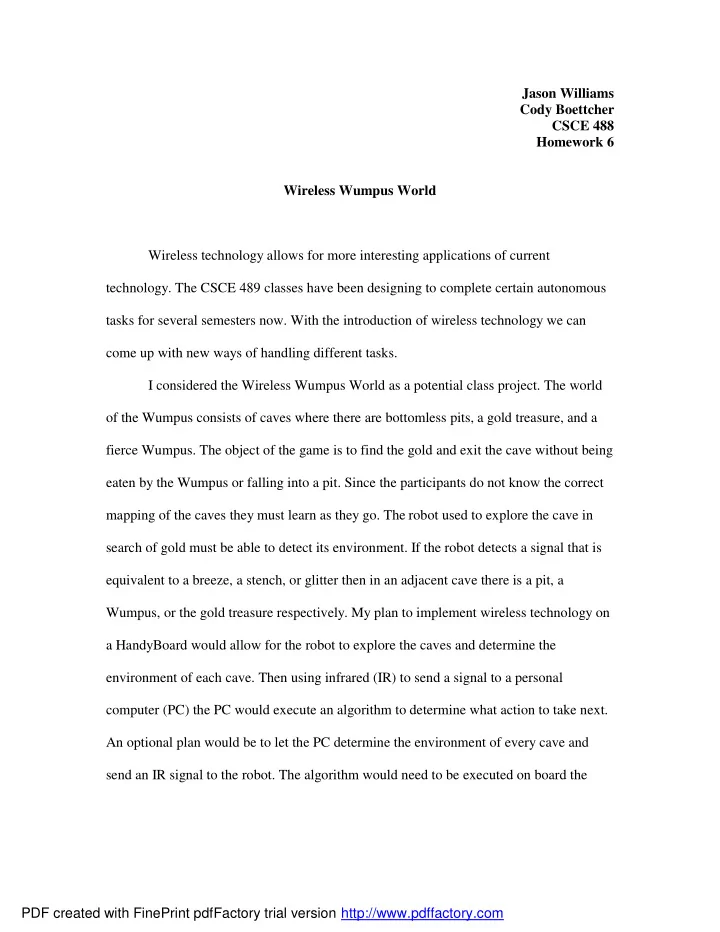

Jason Williams Cody Boettcher CSCE 488 Homework 6 Wireless Wumpus World Wireless technology allows for more interesting applications of current technology. The CSCE 489 classes have been designing to complete certain autonomous tasks for several semesters now. With the introduction of wireless technology we can come up with new ways of handling different tasks. I considered the Wireless Wumpus World as a potential class project. The world of the Wumpus consists of caves where there are bottomless pits, a gold treasure, and a fierce Wumpus. The object of the game is to find the gold and exit the cave without being eaten by the Wumpus or falling into a pit. Since the participants do not know the correct mapping of the caves they must learn as they go. The robot used to explore the cave in search of gold must be able to detect its environment. If the robot detects a signal that is equivalent to a breeze, a stench, or glitter then in an adjacent cave there is a pit, a Wumpus, or the gold treasure respectively. My plan to implement wireless technology on a HandyBoard would allow for the robot to explore the caves and determine the environment of each cave. Then using infrared (IR) to send a signal to a personal computer (PC) the PC would execute an algorithm to determine what action to take next. An optional plan would be to let the PC determine the environment of every cave and send an IR signal to the robot. The algorithm would need to be executed on board the PDF created with FinePrint pdfFactory trial version http://www.pdffactory.com
robot in order to determine the next action. These signals can be easily sent with a TV/VCR remote control. In order to communicate using wireless technology we would have to purchase a transceiver or build one. PC to IR link kits (transceivers) can be found online for around $99. There are online instructions on how to make a parallel port IR transceiver. Most of these components are readily accessible and could probably be made for under $20. Both of these are within the allowed $100 budget. I feel this project could be completed in a semester and has the potential to be very challenging depending on the constraints put on the memory of the HandyBoard, currently 32k, and how the transceiver is to be built. If I had to pick one of our ideas for a class project I would pick the Wumpus project over Volleyball. I think it would be challenging to write the algorithm to move about the caves and I think it would be interesting to build the IR transceiver and put it to use. References: www.robotstorehk.com www.handyboard.com www.rtjcom.com www.rpi.edu PDF created with FinePrint pdfFactory trial version http://www.pdffactory.com
Robot Volleyball Abstract Creatively think about different ways of challenging the robots and their designs in a new and challenging environment. Introduction We decided to implement the traditional American volleyball game and the principles of the game into a Lego robotic competition. Each team is to have two robots, which will function according to the rules and regulations of the competition. Rules Each team will have two robots functioning in different ways where one will be an offensive and the other will be defensive. The offense robot will have some sort of launching device for the volleyball. During the launching stage the opponent’s defensive robot will try to stop the offensive attack. After the offensive robot launches the ball it will remain stationary until the other team responds and launches the ball back. As each team is trying to retrieve the ball the opponent’s defensive robot, fully equipped with sonar sensors, will match the movement of the offensive robot. This will be the most complicated feature of this project. Costs SONAR Sensor $58.00 Polaroid 6500 Sonar Module. The kit contains one driving board with one transducer. Cable and socket for Handy Board Expansion Board included. Polaroid Thrift Store Camera Sonar Sensor $3.00 Conclusion The volleyball game introduces and different aspect to Lego’s by adding a launching mechanism requiring physics before implementation. It’s cost effective, challenging, and new. PDF created with FinePrint pdfFactory trial version http://www.pdffactory.com
PDF created with FinePrint pdfFactory trial version http://www.pdffactory.com
Recommend
More recommend